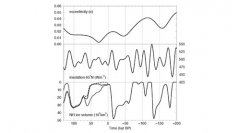

 Comptes Rendus Palevol
5 (1-2) - Pages 21-26
Comptes Rendus Palevol
5 (1-2) - Pages 21-26The astronomical theory of palaeoclimates aims at explaining the recurrence of glacial–interglacial cycles during the Quaternary. It is based upon the long-term variations of the latitudinal and seasonal distributions of the energy that the Earth receives from the Sun. The response of the climate system to this forcing has been simulated by means of the Louvain-la-Neuve (Belgium) model of intermediate complexity. This model reproduces the main climatic features of the last 3 Myr: the entrance into glaciation 2.75 Myr ago; the obliquity cycles from Late Pliocene to Early Pleistocene; the emergence of the 100-kyr cycle 900 kyr ago, the glacial–interglacial cycles of the last 600 kyr, and the climatic variations of the last 200 kyr. In addition to the role played by insolation and greenhouse gases, the model stresses the importance of the feedbacks related to the water vapour, the planetary albedo, the vegetation, the inlandsis and the isostatic rise. Moreover, the analysis of the Quaternary climate has shown that Marine Isotopic Stage 11, 400 000 years ago, was the best analogue of our Holocene. Simulations and sensitivity analyses show that our interglacial will last much longer than most of the others, even without taking into account the impact of human activities on the climate.
Palaeoclimates, astronomical theory, Milankovitch, model, insolation